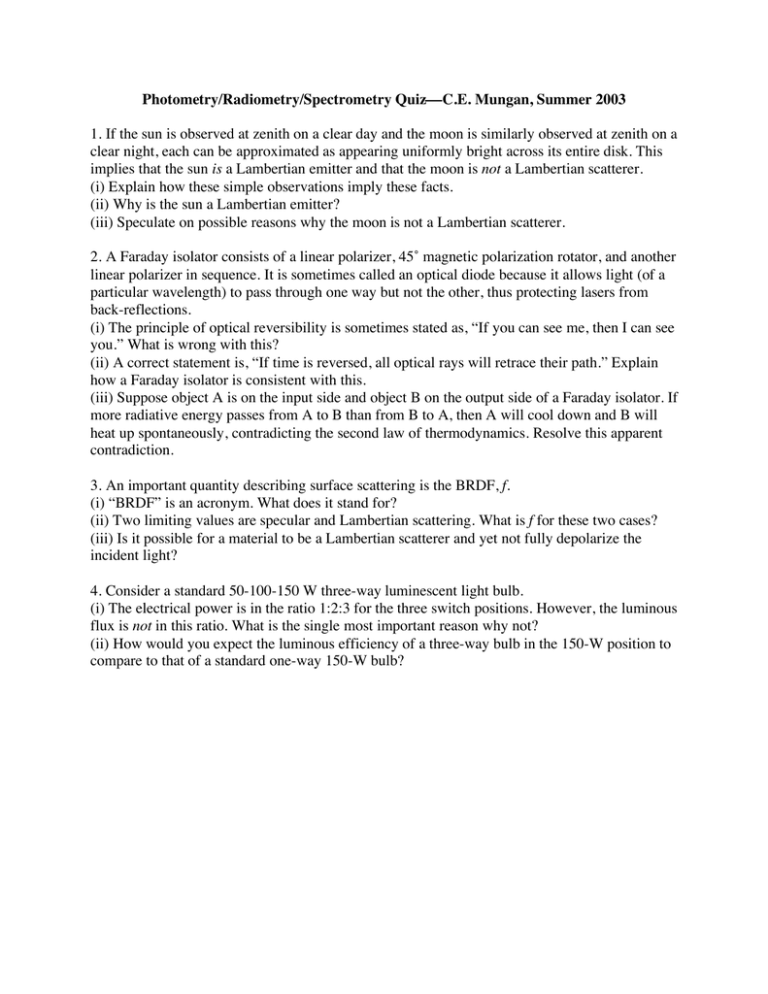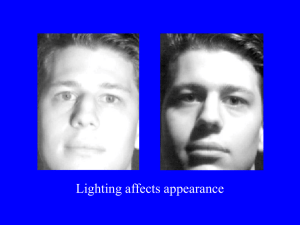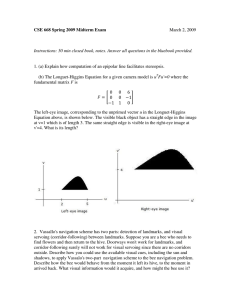Photometry/Radiometry/Spectrometry Quiz C.E. Mungan, Summer 2003
advertisement

Photometry/Radiometry/Spectrometry Quiz⎯C.E. Mungan, Summer 2003 1. If the sun is observed at zenith on a clear day and the moon is similarly observed at zenith on a clear night, each can be approximated as appearing uniformly bright across its entire disk. This implies that the sun is a Lambertian emitter and that the moon is not a Lambertian scatterer. (i) Explain how these simple observations imply these facts. (ii) Why is the sun a Lambertian emitter? (iii) Speculate on possible reasons why the moon is not a Lambertian scatterer. 2. A Faraday isolator consists of a linear polarizer, 45˚ magnetic polarization rotator, and another linear polarizer in sequence. It is sometimes called an optical diode because it allows light (of a particular wavelength) to pass through one way but not the other, thus protecting lasers from back-reflections. (i) The principle of optical reversibility is sometimes stated as, “If you can see me, then I can see you.” What is wrong with this? (ii) A correct statement is, “If time is reversed, all optical rays will retrace their path.” Explain how a Faraday isolator is consistent with this. (iii) Suppose object A is on the input side and object B on the output side of a Faraday isolator. If more radiative energy passes from A to B than from B to A, then A will cool down and B will heat up spontaneously, contradicting the second law of thermodynamics. Resolve this apparent contradiction. 3. An important quantity describing surface scattering is the BRDF, f. (i) “BRDF” is an acronym. What does it stand for? (ii) Two limiting values are specular and Lambertian scattering. What is f for these two cases? (iii) Is it possible for a material to be a Lambertian scatterer and yet not fully depolarize the incident light? 4. Consider a standard 50-100-150 W three-way luminescent light bulb. (i) The electrical power is in the ratio 1:2:3 for the three switch positions. However, the luminous flux is not in this ratio. What is the single most important reason why not? (ii) How would you expect the luminous efficiency of a three-way bulb in the 150-W position to compare to that of a standard one-way 150-W bulb? Answers with References to my Web Pages 1.(i) By definition, a Lambertian emitter appears uniformly bright at all viewing angles and hence the limbs of the sun are as bright as its center. However, the moon is only illuminated by the sun from one direction; thus if it were a Lambertian scatterer, the limbs would appear darker than the center since they receive less light, in proportion to the cosθ projection factor between their normals and the solar direction. (ii) The sun is a blackbody in absorption and thus is a Lambertian emitter. (iii) Both shadow hiding and coherent backscatter occur and are angle dependent. Ref: http://usna.edu/Users/physics/mungan/_files/documents/Publications/BRDFreview.pdf 2.(i) An optical diode is a true one-way mirror: it transmits light in one direction and absorbs light traveling the other way. (ii) The direction of a magnetic field depends on the direction of circulation of charges (either current in an electromagnet or spin and orbital angular momentum in a permanent magnet). If we reverse time, the charge circulation direction and thus the magnetic field direction get reversed. In turn, this switches the transmission direction of the optical diode. (iii) Radiation emitted by B and traveling toward A is absorbed by a polarizer in the optical diode. Consequently this polarizer will heat up and thermally radiate toward A. Note that you cannot avoid this by making the polarizers reflecting instead of absorbing, because the light will then be internally reflected inside the unit until its polarization is rotated into the transmitting orientation, thus defeating the diode mechanism! Ref: http://usna.edu/Users/physics/mungan/_files/documents/Scholarship/FaradayIsolators.pdf 3.(i) BRDF stands for “bidirectional reflectance distribution function.” (ii) A specular reflector scatters light incident from one direction into a unique outgoing direction; hence f for a mirror is essentially a delta function. A Lambertian scatterer diffusely reflects an incident collimated beam into every possible outgoing angle; hence f equals the albedo (which is unity if the surface is unabsorbing) divided by π. (iii) Yes, for example if we cover a rough surface with small mirrored facets, we can diffusely scatter a collimated beam with only single, non-depolarizing reflections of each ray. Ref: http://usna.edu/Users/physics/mungan/_files/documents/Publications/BRDFreview.pdf 4.(i) Running an electrical filament at higher electrical power heats it up, thus increasing the light output superlinearly according to Planck’s law. Other smaller effects include the shift in the spectral output into the visible range by Wien’s law, and the change in tungsten’s resistivity and emissivity with temperature. (ii) Therefore a one-way 150-W bulb should be more efficient than a three-way bulb in the 150W position which is actually merely the simultaneous output of a 50-W and a 100-W filament. Ref: http://usna.edu/Users/physics/mungan/_files/documents/Scholarship/LightOutput.pdf



